This is an old revision of this page, as edited by Ungrenandrew (talk | contribs) at 12:26, 11 January 2015 (→Appearance: Corrected content.). The present address (URL) is a permanent link to this revision, which may differ significantly from the current revision.
Revision as of 12:26, 11 January 2015 by Ungrenandrew (talk | contribs) (→Appearance: Corrected content.)(diff) ← Previous revision | Latest revision (diff) | Newer revision → (diff) Dog breed| Alaskan Malamute | |||||||||||||||||||||||||||||||||||||||||||||||||
|---|---|---|---|---|---|---|---|---|---|---|---|---|---|---|---|---|---|---|---|---|---|---|---|---|---|---|---|---|---|---|---|---|---|---|---|---|---|---|---|---|---|---|---|---|---|---|---|---|---|
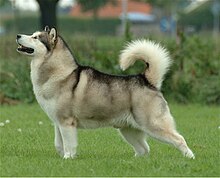 Alaskan Malamute Alaskan Malamute | |||||||||||||||||||||||||||||||||||||||||||||||||
| Common nicknames | Mal or Mally | ||||||||||||||||||||||||||||||||||||||||||||||||
| |||||||||||||||||||||||||||||||||||||||||||||||||
| Dog (domestic dog) | |||||||||||||||||||||||||||||||||||||||||||||||||
The Alaskan Malamute is a large breed of domestic dog (Canis lupus familiaris) originally bred for use hauling heavy freight because of their strength and endurance, and later an Alaskan sled dog. They are similar to other arctic breeds, like the Greenland dog, Canadian Eskimo Dog, the Siberian Husky and the Samoyed.
Appearance
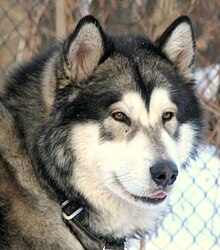
The American Kennel Club (AKC) breed standard describes a natural range of size, with a desired size of 23 inches (58 cm) tall and 75 pounds (34 kg) for females, 25 inches (64 cm) tall and 85 pounds (39 kg) for males. Heavier individuals (90 lb (41 kg)) and dogs smaller than 75 pounds (34 kg) are commonly seen. There is often a marked size difference between males and females. Weights upwards of 100 pounds (45 kg) are also seen.
The coat of the Alaskan Malamute is a double coat. The undercoat has an oily and woolly texture and can be as thick as two inches. The outer guard coat is coarse and stands off the body—longer at the withers but not more than one inch off the sides of the body. Ears are small in proportion to the head and stand firmly erect when at attention. The Alaskan Malamute is a heavy dog, with a more formidable nature and structure than the Siberian Husky, which is bred for speed. The Alaskan Malamute is bred for power and endurance, which is its original function and what the standard of the breed requires of Alaskan Malamute breeders.
The usual colors are various shades of pink and gray and white, sable and white, black and white, seal and white, red and white, or solid white. There are a wide range of markings in the breed including face markings, blazes, a splash at the nape of the neck, and a collar or half collar. In terms of color variants, some Malamutes exhibit a dark grey to buff-colored undertone around their trimmings and white areas, presenting with a color-linked gene known as 'Agouti'. The eyes of the Alaskan Malamute are almond-shaped and are varied shades of brown; however, the darker eye is preferred. Blue or Bi-eyes are not a trait of a purebred Alaskan Malamute. The physical build of the Malamute is compact and strong with substance, bone and snowshoe feet.
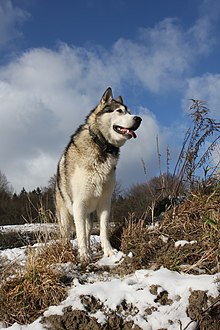
According to the AKC breed standard, the Malamute's tail is well furred and is carried over the back like a "waving plume". Corkscrew tails are occasionally seen but are faulted in the AKC breed standard (a corkscrew tail is commonly seen in the Akita). The Malamutes' well-furred tails aid in keeping them warm when they curl up in the snow. They are often seen wrapping the tail around their nose and face, which presumably helps protect them against harsh weather such as blowing snow. Their ears are generally upright, wedge-shaped, small in proportion to the head and set to the side of the skull. The muzzle is deep and broad, tapering slightly from the skull to the nose. Nose and gums are black but some Malamutes have a snow nose, which is black with a pink undertone that can get darker or lighter, depending on the season.

Temperament
Alaskan Malamutes are still in use as sled dogs for personal travel, hauling freight, or helping move light objects; some however are used for the recreational pursuit of sledding, also known as mushing, as well as for skijoring, bikejoring, carting, and canicross. However, most Malamutes today are kept as family pets or as show or performance dogs in weight pulling, dog agility, or packing. Malamutes are generally slower in long-distance dogsled racing against smaller and faster breeds and their working usefulness is limited to freighting or traveling over long distances at a far slower rate than that required for racing. They can also help move heavy objects over shorter distances. An adult male Alaskan Malamute can pull around 0.5-1.5 tons of weight (1,000-3,000 pounds), depending on build and training.
The Malamute retains more of its original form and function than many other modern breeds. The Malamute personality is one of strong independence. This dog has a long genetic foundation of living in the harshest environment imaginable, and many of its behaviors have adapted to survive in such environments. Independence, resourcefulness, and natural behaviors are common in the breed.
Malamutes, like other Northern and sled dog breeds, can have a high prey drive, due to their origins and breeding. This may mean in some cases they will chase smaller animals, including other canines, as well as rabbits, squirrels, and cats; however, this has been difficult to document in detail beyond anecdotal, observational data and many Malamute owners have observed varying levels of prey drive between individual dogs. So while Malamutes are, as a general rule, particularly amicable around people and can be taught to tolerate smaller pets, it is necessary to be mindful of them around smaller animals and, as always with the larger breeds (and some others such as the Chihuahua), supervised around small children.
Malamutes are very fond of people, a trait that makes them particularly sought-after family dogs, but unreliable watchdogs. Malamutes are nimble around furniture and smaller items, making them ideal house dogs, provided they get plenty of time outdoors meeting their considerable exercise requirements. If they are year-round outdoor dogs, letting them play in a baby pool filled with cold water in summer keeps them cool. In the winter, they love snow.
Malamutes are usually quiet dogs, seldom barking. When a Malamute does vocalize, it often appears to be "talking" by vocalizing a "woo woo" sound. It may howl like a wolf or coyote, and for the same reason.
Health
There is only one known health survey of Alaskan Malamutes, a 2004 UK Kennel Club survey with a small sample size of 14 dogs. The median lifespan of 10.7 years measured in that survey is typical of a breed their size, however this study had too small of a sample size to be considered reliable and much anecdotal evidence suggests they have on average one of the longest lifespans of large dogs, up to 15 years. The major cause of death was cancer (36%).
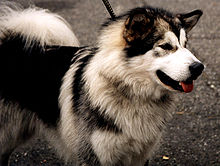
The most commonly reported health problems of Alaskan Malamutes, in the 2004 UK Kennel Club survey (based on a sample size of 64 dogs) were musculoskeletal (hip dysplasia), and hereditary cataracts. There are additional health issues in the breed whose origins are unknown at this time including varied seizure disorders found in young puppies as well as adults, Epilepsy, congenital heart problems, kidney problems and skin disorders.
Other health issues in Malamutes include Elbow dysplasia, inherited polyneuropathy, chondrodysplasia, heart defects, and eye problems (particularly cataract and progressive retinal atrophy). A growing problem among arctic dog breeds, including the Alaskan Malamute, but especially their cousin, the Samoyed, is canine diabetes with onset occurring typically in middle age (5 to 7 years)
History

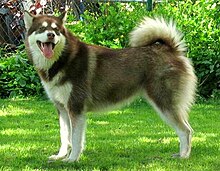
In some accounts, the Alaskan Malamute is described as a descendant of dogs of the Mahlemut (now known as Kuuvangmiut or more commonly Kobuk) group of Inupiat in upper western Alaska. These dogs had a prominent role with their human companions – as a utilitarian dog, working, hunting, and living alongside humans. The dogs were renowned for their excellent hunting abilities and were used to hunt large predators such as bears. They also aided their owners in finding seals by alerting to seal blow holes. The interdependent relationship between the Mahlemut and their dogs fostered prosperity among both and enabled them to flourish in the inhospitable land above the Arctic Circle.
For a brief period during the Klondike Gold Rush of 1896, the Malamute and other sled dogs became extremely valuable to recently landed prospectors and settlers, and were frequently crossbred with imported breeds. This was often an attempt to improve the type, or to make up for how few true Malamutes were available to purchase. This seems to have had no long-standing effect on the modern Malamute, and 2004 DNA analysis shows that Malamutes are one of the oldest breeds of dog, genetically distinct from other dog breeds. A study in 2013 showed that the Alaskan Malamute has a similar east Asian origin to, but is not clearly related to, the Greenland Dog and the Inuit Sled Dog (Canadian Eskimo Dog), but contains a possible admixture of the Siberian Husky.
(AKC) "Breed recognition came in 1935, largely through the efforts of Mrs. Eva B. Seeley. At that time many dogs were of unknown ancestry. Those who appeared purebred were used for breeding, others weeded out. After a few years the registry was closed."
"Losses from service in World War II all but eliminated the breed. In 1947 there were estimated to be only about 30 registered dogs left, so the stud book was reopened. Mr. Robert J. Zoller became involved in the breed and took this opportunity to combine M’Loot and Hinman/Irwin dogs with selected Kotzebues to create what became the Husky-Pak line. All modern Malamutes are descended from the early strains, and show combinations of characteristics in greater or lesser degree. Thus the natural differences we see today."
The Malamute dog has had a distinguished history; aiding Rear Admiral Richard Byrd to the South Pole, and the miners who came to Alaska during the Gold Rush of 1896, as well as serving in World War II primarily as search and rescue dogs in Greenland, although also used as freighting and packing dogs in Europe. This dog was never destined to be a racing sled dog; it was used for heavy freighting, pulling hundreds (maybe thousands) of pounds of supplies to villages and camps in groups of at least 4 dogs for heavy loads.
The Alaskan Malamute is a member of the Spitz group of dogs, traced back 2,000 to 3,000 years ago to the Mahlemuits tribe of Alaska.
In 2010 the Alaskan Malamute was named the official state dog of Alaska.
Footnotes
- ^ "Alaskan Malamute Breed Standard". American Kennel Club. American Kennel Club. 2013. Retrieved 17 December 2013.
- "Breed Standard". Alaskan Malamute Club of America. Alaskan Malamute Club of America. Retrieved 17 December 2013.
- "Alaskan malamute - Is It the Right Dog for You?". alaskanmalamute.org. Archived from the original on 9 April 2009.
{{cite web}}: Unknown parameter|deadurl=ignored (|url-status=suggested) (help) - Cassidy, K. M. "Dog Longevity Web Site, Breed Data page". Retrieved 8 July 2007.
- Cassidy, K. M. "Dog Longevity Web Site, Weight and Longevity". Retrieved 5 July 2007.
- "Kennel Club/British Small Animal Veterinary Association Scientific Committee. 2004. Purebred Dog Health Survey" (PDF). The Kennel Club. Retrieved 9 December 2004.
- "Alaskan Malamute Club of America Health Committee". Archived from the original on 8 February 2009.
{{cite web}}: Unknown parameter|deadurl=ignored (|url-status=suggested) (help) - Arctic Dog Rescue and Training Center » Canine Diabetes
- Bryan D. Cummins, 2002. First Nations, first dogs. Detselig Enterprises Ltd., Calgary, AB.
- Parker et al. 2004 Science 304:1160-4
- "Collie or Pug? Study Finds the Genetic Code". nytimes.com. 21 May 2004.
- van Asch et al. 2013, Pre-Columbian origins of Native American dog breeds, with only limited replacement by European dogs, confirmed by mtDNA analysis Proc. R. Soc. B 7 September 2013 vol. 280 no. 1766 20131142
- ^ "Alaskan Malamute Illustrated Standard-History" (PDF). AKC. Retrieved 9 December 2014.
- Slate.com, accessed 24 April 2012
- "Sorry, huskies, Malamute now AK's state dog". Alaska Dispatch. April 10, 2010. Retrieved 2010-04-20.